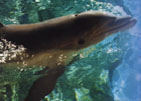 |  |  |
|
Family: |
These dolphins are about a meter (3 feet) in length when born. When they are young, Atlantic Humpbacked dolphins do not have a hump. As they grow older, the hump will form just in front of it's dorsal fin, giving the dolphin its name. This hump can be a third of the total length of the dolphin, and is quite distinctive. They are generally gray in color, with a lighter color along their underside, but can be slightly speckled. The rostrum is long and slender, and pectoral fins are broad with rounded tips. Found along the west coast of Africa, they prefer shallow coastal waters, but may also be seen in estuaries and sometimes in the Niger and Bandiala river, though they don't travel far upstream. They sometimes travel with and can be confused with bottlenose dolphins, especially in younger individuals. However, as the dolphin ages, the hump does make them distinctive between the two species. The Indo-Pacific Humpbacked Dolphin closely resembles the Atlantic Humpbacked dolphin, though the two species never mix, being in two different oceans. These two dolphins, while looking similar, also differ in number of teeth and vertebrae. Though shy of boats, Atlantic Humpbacked Dolphins have been known to assist fisherman. Off the coast of Mauritania, the dolphins drive mullet into the nets of the fisherman so that both can share the catch.
| |
